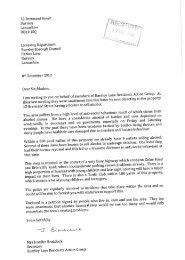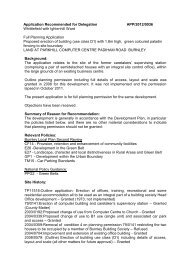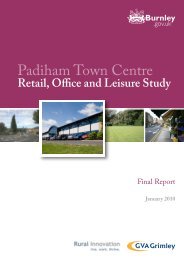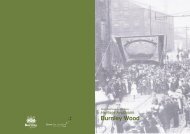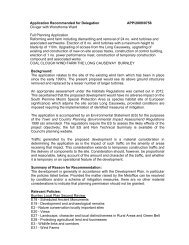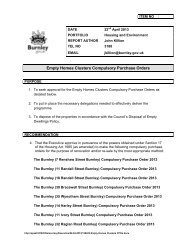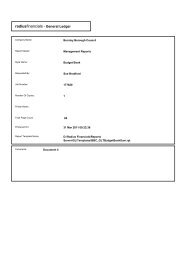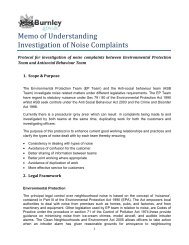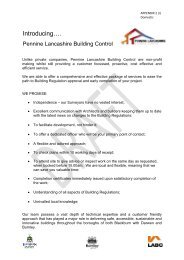The Padiham Heritage Appraisal - Burnley Borough Council
The Padiham Heritage Appraisal - Burnley Borough Council
The Padiham Heritage Appraisal - Burnley Borough Council
- No tags were found...
You also want an ePaper? Increase the reach of your titles
YUMPU automatically turns print PDFs into web optimized ePapers that Google loves.
3.6.5 <strong>The</strong> former <strong>Padiham</strong> Liberal Club is a dominant andimpressive feature on <strong>Burnley</strong> Road. <strong>The</strong> three-storey, stonebuilt property is now occupied by a number of retail businessesand cafes on the ground floor and a youth centre within its upperfloors. Built in 1897/8 by architects Messrs Hitchen and Pritchardof Yorkshire, the four shops on the ground floor were incorporatedinto the original building, the club itself being on the second andthird floors. <strong>The</strong> building replaced the Trades Hall which during theCotton Famine (early 1860s) had been converted by Sir JamesKay Shuttleworth for use as a soup kitchen and workingmen’sclub. It was given to <strong>Padiham</strong> Liberal Club in 1870. <strong>The</strong> TradesHall was itself a conversion of <strong>Padiham</strong> Corn Mill, which had beenin operation on the site up to 1852 (Haines & Jones, 2006, pers.comm).Former Liberal Club, <strong>Burnley</strong> Road3.6.6 <strong>The</strong> former Weavers’ Institute on Sowerby Street appearson the 1890 OS map. <strong>The</strong> building is constructed with a sandstoneashlar elevation to Sowerby Street and coursed rubble to thegables and rear. <strong>The</strong>re has been little alteration to its exterior,which still retains its ornate door casements, and windows, eachetched with the term ‘Reading Room’.Former Weavers’ Institute, Sowerby Street3.7. Churches3.7.1 Before the 15th century there was no place of worship in<strong>Padiham</strong>. <strong>The</strong> town was part of the very large parish of Whalleyand its inhabitants would have attended the churches in Whalleyor Altham. In 1451 John Marshall, a native of <strong>Padiham</strong>, who madehis career in the church, founded a chantry chapel dedicated to St.Leonard. In the 1520s during the reign of Henry VIII the chantry wasrebuilt in stone and <strong>Padiham</strong> became a parochial chapelry carryingout the functions of a parish church with the right to baptise,marry and bury its parishioners. Abbot Paslew, the last Abbott ofWhalley before the dissolution of the monasteries, donated anoctagonal stone font to the new church, which was resited in thepresent building. <strong>The</strong> nave of the church was rebuilt in 1766. <strong>The</strong>tower and the chancel of the original building still remain. <strong>The</strong>building was completely demolished in 1866 and the present St.Leonard’s Church built in the style of 15th century Gothic by WilliamWaddington (Haines & Jones, 2006, pers.comm). Constructed fromhammer dressed sandstone with ashlar dressing, the church hasa steeply pitched slate roof. Its tower rises 118ft and houses eightbells.This view of St. Leonard’s has been taken fromChurch Lane. Today the church is statutorily listedGrade II and its tower is an important landmarkstructure dominating the town’s skyline (Plans A & F).3.7.2 <strong>The</strong> 18th and 19th centuries were a period of religiousrevival. New places of worship were needed in the expandingindustrial towns, not only for the Church of England but also fornonconformists and later the Roman Catholics.heritage appraisal 25



